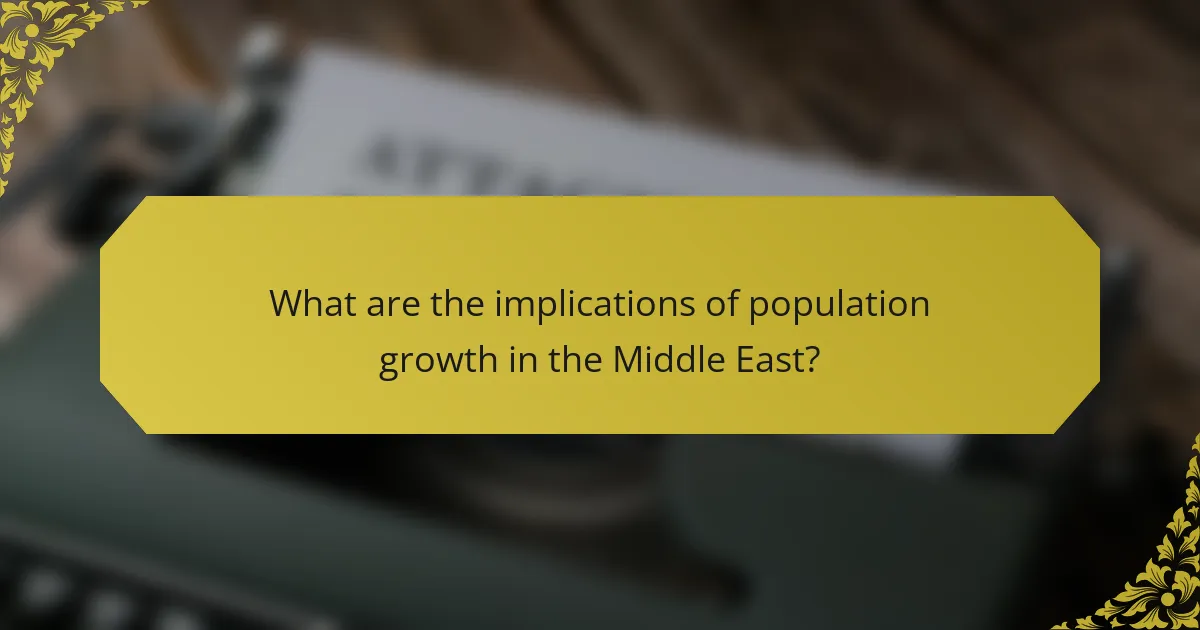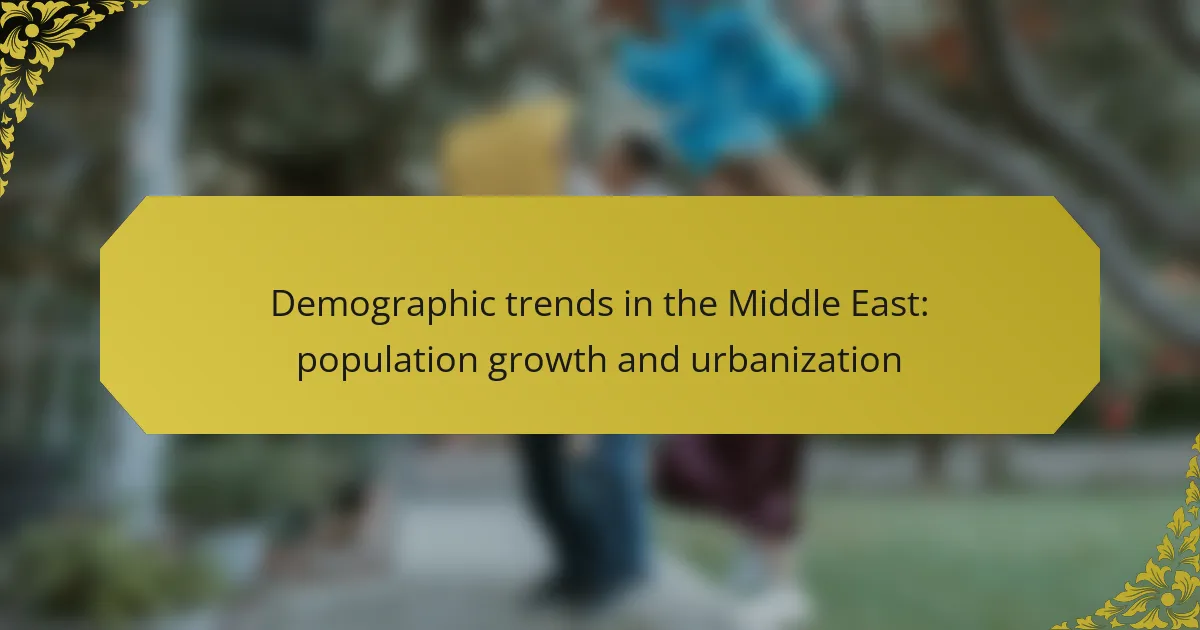
What are the key demographic trends in the Middle East?
Key demographic trends in the Middle East include rapid population growth and increasing urbanization. The region has one of the highest population growth rates globally, with a growth rate of approximately 1.9% per year. This growth is driven by high birth rates and declining mortality rates. Urbanization is also significant, with over 60% of the population living in urban areas. Cities like Cairo and Riyadh are expanding rapidly, leading to increased demand for housing and services. Additionally, youth make up a large portion of the population, with around 50% under the age of 25. These trends impact economic development and social dynamics in the region.
How has population growth evolved in the Middle East?
Population growth in the Middle East has experienced significant changes over the past few decades. From the 1950s to the 1980s, many countries saw rapid population increases due to high birth rates and improvements in healthcare. For instance, countries like Iraq and Saudi Arabia had growth rates exceeding 3% annually during this period.
In the 1990s, growth rates began to decline slightly as family planning initiatives gained traction. However, some countries, like Yemen, continued to experience high growth rates, with estimates of around 3.5% in the early 2000s.
Currently, the region’s population growth varies significantly, with Gulf states like Qatar and the UAE seeing high growth due to immigration, while countries like Lebanon and Jordan experience slower growth rates. The overall population of the Middle East is projected to reach around 600 million by 2050, reflecting ongoing demographic shifts.
These trends highlight the complex interplay of factors influencing population growth in the region, including economic development, migration, and social policies.
What factors contribute to population growth in the region?
Population growth in the region is primarily driven by high birth rates and declining mortality rates. Fertility rates in many Middle Eastern countries exceed the global average. Improved healthcare has significantly reduced infant and maternal mortality. Economic development also contributes to better living conditions. Migration patterns, including both internal and international movement, further influence population dynamics. Urbanization attracts people to cities, increasing population density. These factors collectively result in a rapid increase in the region’s population. For instance, countries like Iraq and Yemen have experienced significant growth due to these factors.
How does the birth rate in the Middle East compare to other regions?
The birth rate in the Middle East is generally higher than in many other regions. As of recent data, the Middle East averages around 2.5 to 3.5 births per woman. This rate is notably higher than in Europe, where the average is about 1.5 births per woman. Factors contributing to this difference include cultural norms and economic conditions. In contrast, regions like North America also report lower birth rates, averaging around 1.8 births per woman. The Middle East’s higher birth rate is influenced by factors such as higher fertility rates in certain countries and demographic trends. Countries like Iraq and Yemen exhibit some of the highest birth rates globally, further elevating the regional average.
What role does urbanization play in demographic changes?
Urbanization significantly influences demographic changes by altering population distribution and growth patterns. It leads to increased migration from rural to urban areas. This shift results in higher urban population densities. Urban areas often provide better economic opportunities and access to services. Consequently, urbanization can accelerate population growth in cities. It also affects age structure, as younger populations tend to migrate to urban centers. Furthermore, urbanization can lead to changes in family structures and household sizes. This phenomenon is evident in the Middle East, where rapid urbanization has been observed in countries like Saudi Arabia and Egypt. According to the United Nations, urban populations in the Middle East are projected to reach 75% by 2050, highlighting the profound impact of urbanization on demographic trends.
How has urbanization impacted population distribution in the Middle East?
Urbanization has significantly altered population distribution in the Middle East. Rapid urban growth has led to increased migration from rural areas to cities. Cities like Dubai, Riyadh, and Cairo have seen substantial population surges. Approximately 85% of the Middle Eastern population now lives in urban areas. This shift has resulted in overcrowding in major cities. Infrastructure and housing demands have surged due to this urban influx. Rural areas have experienced population decline and economic challenges. Urbanization trends are expected to continue, further shaping demographic patterns in the region.
What are the major cities experiencing rapid urban growth?
The major cities experiencing rapid urban growth in the Middle East include Dubai, Riyadh, and Istanbul. Dubai has seen a population increase of over 20% in the last decade. Riyadh’s population is projected to reach 8 million by 2030, reflecting significant urban expansion. Istanbul continues to grow, with a current population of approximately 15 million. This growth is driven by economic opportunities and migration. Urbanization in these cities is supported by infrastructure development and investment. Thus, these cities exemplify significant demographic trends in the region.

What are the implications of population growth in the Middle East?
Population growth in the Middle East leads to significant economic, social, and environmental implications. The region’s population is projected to exceed 600 million by 2050. This rapid increase strains resources such as water and food. Urbanization accelerates as people migrate to cities for better opportunities. Overcrowding in urban areas can lead to inadequate housing and infrastructure. High youth populations may result in increased unemployment rates if job creation does not keep pace. Social tensions can rise due to competition for limited resources. Environmental degradation is likely as demand for land and energy increases. These factors collectively impact stability and development in the region.
How does population growth affect economic development?
Population growth affects economic development by increasing the labor force and consumer base. A larger workforce can lead to higher productivity and economic output. For instance, countries with rapid population growth, like those in the Middle East, often experience a surge in demand for goods and services. This demand can stimulate investment and innovation. However, if population growth outpaces economic growth, it may lead to unemployment and strain on resources. According to the World Bank, regions with balanced population growth and economic development can achieve sustainable growth. In contrast, excessive growth without corresponding economic opportunities can exacerbate poverty and inequality.
What challenges does a growing population pose for job creation?
A growing population poses significant challenges for job creation. Increased population density leads to a higher demand for jobs. This demand can outpace the available job opportunities. Economic growth may not keep up with population growth. Many regions may struggle to provide sufficient employment. Unemployment rates can rise as a result. Youth unemployment is particularly pronounced in rapidly growing populations. For instance, the Middle East faces high youth unemployment rates, often exceeding 25%. This situation can lead to social unrest and economic instability.
How can population growth drive innovation and entrepreneurship?
Population growth can drive innovation and entrepreneurship by increasing demand for goods and services. A larger population creates diverse market needs. This diversity encourages entrepreneurs to develop new solutions. Increased competition often leads to improved products and services.
Additionally, a growing population can lead to a more skilled workforce. More individuals entering the job market can foster collaboration and idea exchange. Urban areas, often experiencing population growth, become hubs for startups and innovation.
Research shows that regions with higher population density often see increased patent filings and tech startups. For instance, cities like Dubai have experienced entrepreneurial booms due to significant population increases. This trend highlights the relationship between population growth and economic dynamism.
What are the social implications of urbanization in the Middle East?
Urbanization in the Middle East has significant social implications. It leads to increased migration from rural to urban areas. This shift alters community structures and traditional family dynamics. Urbanization also contributes to the growth of informal settlements, often lacking basic services. These areas face challenges such as inadequate housing and sanitation. Additionally, urbanization can exacerbate social inequalities. Disparities in access to education and employment opportunities become more pronounced. The rapid growth of cities often strains infrastructure and public services. This situation can result in increased social tensions and unrest.
How does urbanization impact access to education and healthcare?
Urbanization significantly impacts access to education and healthcare. Urban areas typically offer better educational facilities and healthcare services compared to rural regions. Increased population density in cities leads to more schools and hospitals being established. According to the World Bank, urbanization can enhance the availability of resources, such as trained teachers and medical professionals. However, rapid urbanization can also strain these services, leading to overcrowding and reduced quality. In some cases, marginalized communities may face barriers to accessing these essential services. For instance, studies show that urban slums often lack sufficient educational and healthcare infrastructure. Overall, urbanization presents both opportunities and challenges for access to education and healthcare.
What are the effects of urbanization on cultural identity in the region?
Urbanization significantly impacts cultural identity in the region. It often leads to the dilution of traditional practices. Migration to urban areas can result in the blending of diverse cultures. This cultural mixing can create new identities but may also erode local customs. For example, younger generations may adopt urban lifestyles over traditional ones. Studies indicate that urbanization can increase exposure to global influences. This exposure often shifts cultural values and social norms. Consequently, the unique cultural heritage may face challenges in preservation.

What are the future projections for demographic trends in the Middle East?
Future projections for demographic trends in the Middle East indicate significant population growth and urbanization. By 2050, the region’s population is expected to reach approximately 600 million. This growth is driven by high fertility rates and declining mortality rates. Urbanization will continue, with over 70% of the population living in urban areas by 2040. Countries like Saudi Arabia and the UAE will see rapid urban expansion. The youth population will remain a substantial demographic segment, with over 50% under the age of 30. These trends reflect broader global patterns but are intensified in the Middle East due to specific socio-economic factors.
How is the population expected to change in the next decade?
The population in the Middle East is expected to increase significantly over the next decade. Projections indicate a growth rate of approximately 1.5% annually. By 2030, the region’s population could reach around 500 million. This growth is driven by high birth rates and improving healthcare. Urbanization will continue, with more people moving to cities for better opportunities. Countries like Egypt and Saudi Arabia will see substantial increases. The demographic shift will impact economic and social structures. These trends are supported by data from the United Nations Population Division.
What demographic factors will influence future population growth?
Fertility rates, migration patterns, and age distribution are key demographic factors influencing future population growth. Fertility rates in the Middle East vary significantly, with some countries experiencing high birth rates. For instance, Niger has a fertility rate of 6.9 children per woman, while countries like Lebanon have lower rates around 1.7. Migration patterns also play a crucial role; countries like the UAE attract expatriates, impacting overall population numbers. Additionally, age distribution affects growth potential. A younger population generally leads to higher growth rates. According to the United Nations, the region’s population is expected to grow by 30% by 2050, largely due to these demographic factors.
How will urbanization trends evolve in the coming years?
Urbanization trends in the coming years will likely accelerate due to rapid population growth in the Middle East. By 2050, the urban population in this region is expected to exceed 80%. This shift is driven by economic opportunities in urban areas. Increased job availability attracts rural populations to cities. Infrastructure development will also support urban expansion. Governments are investing in smart city initiatives. These initiatives aim to improve living conditions and sustainability. Additionally, migration patterns from rural to urban areas will continue. Urbanization will reshape social dynamics and economic structures in the Middle East.
What strategies can be implemented to manage demographic changes effectively?
Effective strategies to manage demographic changes include enhancing urban planning and infrastructure development. Urban planning must accommodate population growth and migration patterns. Infrastructure improvements should focus on transportation, housing, and public services.
Policy adjustments can promote economic opportunities in urban areas. This includes investing in job creation and skills training. Education systems should be adapted to meet the needs of a changing population.
Community engagement is essential for understanding local needs. This can involve participatory planning processes. Governments should utilize data analytics to inform demographic trends.
Regional cooperation can enhance resource sharing and strategic planning. Collaborative efforts can address cross-border demographic challenges.
These strategies are supported by successful case studies from urban centers. Cities like Dubai have implemented comprehensive urban planning to manage rapid growth.
What are best practices for sustainable urban development in the Middle East?
Best practices for sustainable urban development in the Middle East include integrating green spaces into urban planning. Green spaces improve air quality and enhance residents’ well-being. Implementing energy-efficient building standards reduces energy consumption. The use of renewable energy sources, such as solar power, is essential. Water conservation techniques, like greywater recycling, help manage scarce resources. Promoting public transportation reduces traffic congestion and emissions. Engaging local communities in planning fosters social equity and inclusiveness. Finally, utilizing smart city technologies enhances infrastructure efficiency and sustainability. These practices collectively address the unique challenges of urbanization in the region.
How can governments prepare for the challenges of population growth?
Governments can prepare for the challenges of population growth by implementing comprehensive urban planning strategies. Effective urban planning can accommodate increasing populations in cities. This includes developing infrastructure such as transportation, housing, and public services. Governments should also invest in sustainable resource management to ensure essential services remain available. Education and healthcare systems need expansion to meet growing demands. Additionally, policies should encourage economic diversification to create jobs. Historical data indicates that cities experiencing rapid growth face significant strain on resources. Therefore, proactive measures are essential for maintaining quality of life in urban areas.
Demographic trends in the Middle East are characterized by significant population growth and urbanization. The region experiences one of the highest population growth rates globally, driven by high birth rates and declining mortality rates, with projections indicating a population of around 600 million by 2050. Urbanization is also a key trend, with over 60% of the population currently living in urban areas, leading to increased demand for housing and services. The article explores the evolution of population growth, factors contributing to it, and the implications for economic development, social dynamics, and urban infrastructure in the region. Additionally, it discusses future projections and strategies for managing these demographic changes effectively.


